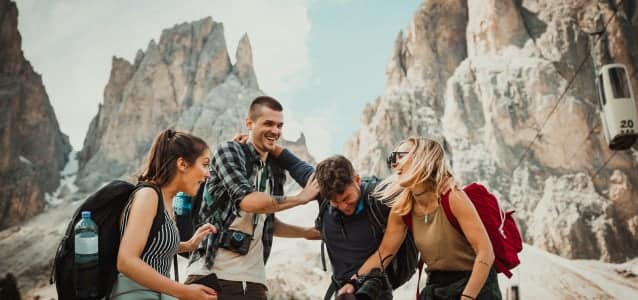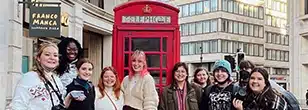Transportation in the U.S.
Before you embark on your journey to the U.S., it’s important to learn a little more about the city or town, state, and general region where you will be living. The U.S. is a very diverse and expansive country, and is made up of major cities, suburbs, and rural communities. The more familiar you are with your host city, the easier it will be to get around!
Locations
Big City Living
Examples:
What to Expect: Depending on where you live, there will most likely be multiple options for transportation. Most major cities have a subway or metro system and an extensive bus system to get around the city quickly and easily. Many cities have shared bike systems with growing coverage areas.
These are typically the most common ways that city dwellers get to their office and around the city! It’s also a good idea to ask your co-workers or new local friends what they recommend in terms of getting around the city.
Suburban Spots
Examples:
- Alameda, Contra Costa, Marin, Napa, San Mateo, Santa Clara, Solano, and Sonoma (Greater San Francisco area)
- Bethesda (Maryland)
- Evanston (Illinois)
- Orange County, Ventura County, Inland Empire, (Greater Los Angeles Area)
- Cambridge, Charlestown, Brookline, Somerville, Allston, Jamaica Plain (Boston)
- Westchester County and Long Island (New York) and New Jersey (New York metro area)
What to Expect: Public transportation is more limited in the suburbs, and most residents don’t live close enough to walk where they need to go; a car becomes a necessity. If you’re not sure how close the suburb is to a major city, check with your host employer to find out where most people at the company live and how they get to work. It may be possible to ride a bike or take a bus to a larger train station for your commute into the city.
- If you’re living in a suburb away from a major bus line, commuter train, or subway stop, you will most likely need a car.
- If you are living in a major city but working in a suburb, you will do what is called “reverse commuting” and can probably take a train or bus to your office outside the city.
- If your office is not close to a bus or train stop, you may need to drive or use a combination of bus/train and walking/biking.
- Before you confirm your housing, you may want to seek advice from your host employer and coworkers on the most convenient suburban neighborhoods for public transportation access.
Rural Regions
Examples:
- The Midwest
- Southern States
- Northern Florida
- Pennsylvania
What to Expect: Some of the most beautiful places in the U.S. are in the countryside. Living in a rural area is a great way to immerse yourself in American culture and meet locals. People in the countryside are known to be the friendliest Americans. You will almost certainly need to have a car if your program is in a rural area. Even if there is public transportation, such as a bus line, it may not run often enough to get you where you need to go.
Types of Transportation
Car
Unless you live in or close to a major city, you will probably need access to a car. If you do plan to drive in the U.S., it is recommended that you get an international driver’s license before you arrive, as you cannot get one once you’re in the U.S.
When driving, use extra caution and:
- Remember that cars drive on the right side of the road in the U.S.
- Never drive after drinking alcohol and never get into the car with a driver who has been drinking.
- Always wear a seat belt.
- Stay on marked roads.
- Be aware of special weather and road conditions (e.g., snow, fog, flooding).
- Use extra care around school buses, trucks and large vehicles.
- Follow parking rules.
- Be aware of pedestrians and cyclists.
- Do not text or use your cellphone while driving.
- Don’t speed.
The best resource for driving laws and for obtaining a driver’s license is the DMV (Department of Motor Vehicles) for the state in which you will be driving. The American Automobile Association, also known as AAA or Triple A, is a membership organization that provides services such as travel and automotive support – for instance, when your car breaks down – and insurance.
If you know you’ll be driving in the U.S., make sure to read our guide: How to Drive, Insure, Buy and Register a Car in the U.S.
Additional Driving Resources:
Subway/Metrorail
Only major cities in the U.S. have subway systems. Their efficiency depends on the city. If you will be living and working in a major city, this is most likely the way you will travel to work.
Subway fares depend on the city, but most will have options to purchase weekly or monthly passes, a certain number of trips at a time, or a specific dollar amount. Most subway systems maintain apps with subway system information, including maps, schedules, and planned service disruptions. Tourism centers will also have maps.
Local Bus
Depending where you live, taking a bus to your host employer’s office or to get around town might be the best option. The majority of major cities will have bus lines, but the frequency and routes of the buses will vary.
Generally, you can buy a pass or ticket for the bus, but if you pay cash, you will almost always need to give the driver exact change in coins.
For more information about public transportation in your host city, visit the American Public Transportation Association website.
Biking
Riding a bike is a wonderful and environmentally-friendly way to get around.
Remember to always:
- Wear a helmet and be aware of your surroundings.
- Ride in the direction of traffic and wear reflective clothing and lights when riding at night.
- Ride in designated bike lanes.
- Have a bike lock, too, to keep your bike safe.
Read more on the National Highway Traffic Safety Administration website.
Long Distance Bus
For traveling to other cities or distances under eight hours by car, you may want to consider taking the bus. This is a great, inexpensive way to travel between cities without taking a train or plane, which can be costly.
Some of these companies have low fare specials. You will book your ticket online and print it out for easy boarding.
Here are some of the most popular lines:
Train
Trains are a faster and more comfortable way to get from city to city rather than taking a bus, but the ticket price will typically be much higher.
The nationwide train system is Amtrak. Enter your departure and destination cities and see your options for travel.
Air
If you’re looking to travel long distances, flying is generally the best option. If you book your ticket far enough in advance, you can usually get a good deal. However, flying is typically the most expensive form of transportation.
The websites below are great resources for booking flights because they compare multiple airlines at once.
Travel Deals
Some of these discount websites, besides offering deals for your city or town, offer trips for discounted prices in the U.S. and around the world:














